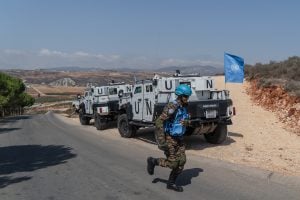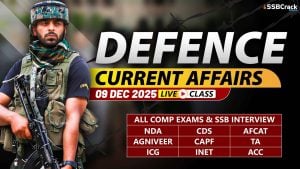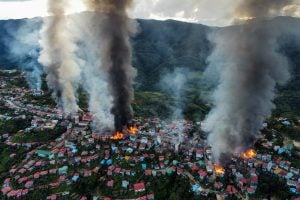Jai Hind future warriors, we all have read in various news pieces about the necessity of UAVs, Drones, and RPAs for forces to maintain external and internal security. In this blog, we will be learning about what are these types of machinery and their importance.
UAV(Unmanned Aerial Vehicle)
The UAV is an aerial vehicle with no pilot to man controls. They can be remotely controlled by personnel on the ground or by pre-programmed flight plans. It is the onboard computer of the plane that actually controls it and reacts to changing conditions in order to reach the desired location.
UAVs are being extensively used for aerial reconnaissance, mapping, etc.
The Indian armed forces have been operating UAVs for more than a decade now, initially the Searcher Mark I, was obtained, followed by the Searcher Mark II. Besides the Nishant UAV developed by the DRDO is also in service.
The indigenously developed Rustom-I and Rustom-II, by DRDO will replace/supplement the Heron UAVs in service with the Indian armed forces
UAVs have played a crucial role during Af-Pak operations. Many tops and mid-level Al Qaida and Taliban leaders have been killed in US UCAV raids. Their effective and successful use shows a clear direction.
Drone
The term “drone” was originally applied to pilotless airplanes used in target practice. These are machines/vehicles that are piloted through pre-programmed computer software or a remote pilot. Hence, a Drone can also be called an Unmanned Aerial Vehicle (UAV).
Even if a plane, boat, or car is remotely controlled by a human being in a different location, it can still be considered a drone. The important part is that the vehicle doesn’t have human piloting or driving it inside. So, going back to our point, those flying objects that we call “drones” are indeed covered by the definition of what a drone is.
The word “drone”, however, is popularly used to describe those flying objects that we tend to control remotely either using from a different location. You would have probably heard the term “drone” used by the military to describe a flying airplane or vehicle that they use for drone strikes or airplane bombings that they do without the intervention of an actual pilot in the cockpit of the plane.
These drones have made a huge difference in the way the military has been conducting its operations as they can perform different tasks remotely and without putting an actual person in danger. And the best part is that they can do this from miles and miles away without the need to be close to the drone.
Commercially speaking, we refer to drones as those small flying objects that hobbyists use for a lot of different purposes. These are objects that can be controlled remotely using our smartphones or a dedicated remote control made for the drone itself. So, when we are talking about drones in the more popular sense, we are usually referring to these commercial drones, which are readily available for anyone to use and are far from the militarized version of what a drone is.
Because these drones are commercially sold, they do not have any weapons whatsoever and, at the most, have cameras that can also be remotely controlled. Meanwhile, commercial drones cannot be controlled from a faraway distance as the best commercial drones can only be controlled from a handful of miles away at the max. So, when we are talking about drones, we are usually referring to these small flying objects.
Still, the real meaning of the term “drone” covers virtually any vehicle that can move without the help of a pilot or a driver inside. So, again, a drone can be anything that can move on air, sea, or land as long as it can autonomously move or can be controlled remotely from a different location.
RPV(Remotely Piloted Vehicle)
The Remotely Piloted Vehicle (RPV) is a type of UAV with a similar basic design and structure. However, in the case of an RPV, the pilot is not really eliminated but just relocated to a remote and safe location.
The RPV still functions as a typical airplane, and the pilot still has a cockpit with all the necessary controls except that the inputs provided by the pilot are now transmitted to a military satellite which then sends it to the RPV.
Therefore, it can still be tasked with missions that are typically done by piloted planes, like surgical strikes on high-value, high-risk targets, without any risk to the pilot.
For Example- Let’s say the target is in enemy land and we have transmitted the pilot to a safe zone near the area to be bombed. Then the pilot may operate the RPV to bomb the enemy area while being at the safe zone.
We have seen RPV in movies/series being used by pilots sitting in vehicles from where they control their plane and then use it. This is the essential difference between UAV/Drones and RPV as RPV requires a pilot whereas UAV/Drones may or may not have a pilot.
Difference Between UAV and Drone
- DRONE is itself an acronym, which means Dynamically Remote Operated Navigational Equipment. The misconception is that anything flies with four rotors is a Drone, which is actually not. Drone can fly, run on Ground, and can Dive into water. UAV is one of its classification, which follows pre-programmed path or operated remotely by a pilot
- The subtle difference that has emerged during recent times is that the UAVs are invariably unarmed and used mostly for surveys, mapping, visual and thermal imaging of a region and other less lethal tasks, whereas, Drones are generally armed with lethal weapons and have more of military application like inflicting casualties to militant leaders and destruction of their war waging machinery.
- A drone, in military use, is usually an unmanned aerial vehicle (UAV) which has been guided onto its target by remote control from another location; it can also mean an aircraft that remains under the complete control of a pilot or operator at all times. The drone commonly strikes with missiles and bombs, launched from land or air. To remotely operate a drone often means having to carefully manage line of sight between drone and controlling station.
- Thus, any flying drone has to be a UAV, but not every UAV has to be a drone.
- Example of drone is the US origin Predator XP being procured by India.
Importance of the UAVs, Drones, and RPVs
Surveillance
One of the most important reasons the military uses drones is for surveillance for gathering intelligence. Aircraft like the Global Hawk and the newer Ultra LEAP — which has clocked 18,000 combat flight hours — are critical to surveillance missions run by military branches. Ones like the Ultra LEAP are capable of flying long distances and taking off and landing remotely. Drones solve a big problem in this sense: Surveillance drones allow for long-range missions while keeping military personnel out of harm’s way.
Reconnaissance
The RQ-1 is the reconnaissance version of the Predator UAV (also known as an Unmanned Aerial Vehicle) which encompasses any flying drone in the military. Reconnaissance aircraft can stay in the air for long periods of time — 24 hours in the case of the RQ-1 — and are equipped with several cameras capable of capturing both video and still images. A big role UAV/Drones play here is that: Reconnaissance drones can provide real-time information on enemy positions before U.S. troops arrive on site.
Situational Awareness
Similar to reconnaissance, situational awareness provides real-time information about enemy positions, weather, terrain, and other changing variables. Situational awareness is amplified with the use of drones. Being able to see what is and what isn’t nearby troop locations helps them make educated decisions on how to proceed safely. It is important because: Being able to anticipate what’s about to happen in a combat zone is the difference between life and death.
Battle Assessment Damage
Battle Assessment Damage (BDA) may be used to determine if strikes on enemies were effective overall. This is especially important in fast-moving missions where reports need to be turned over quickly to leadership for the next mission decisions.
BDA is the “assessment is the timely and accurate estimate of damage resulting from the application of military force, either lethal or non-lethal, against a predetermined objective,”.
BDA is important because: This type of drone activity can determine the amount of damage and potential collateral damages made. Various air forces also use this assessment to determine how long it will take to make their airbases operable after an attack.
Weapon Delivery
Not all drones are tiny. The military uses larger Unmanned Combat Air Vehicles (UCAV) to deliver airstrikes on remote targets. You may have seen this type of exercise on various television shows, but it’s a real-life exercise that’s carried out by the military.
These UCAVs typically carry light-weight bombs and missiles that are delivered with precision to select targets. The MQ-9 Reaper is one of these remotely piloted aircraft that can fly up to 50,000 feet. The cost for the unit amounts to $64.2 million.
This is important because of the following reason: To minimize service personnel risk in dangerous combat situations, UCAVs are ideal for missions that need precision.
Drone Swarm
Precisely defined, drone swarms are “multiple unmanned platforms and/or weapons deployed to accomplish a shared objective, with the platforms and/or weapons autonomously altering their behaviour based on communication with one another.” The fact that components of the swarm can communicate with one another makes the swarm different from just a group of individual drones. Communication allows the swarm to adjust behaviour in response to real-time information. Drones equipped with cameras and other environmental sensors (“sensor drones”) can identify potential targets, environmental hazards, or defences and relay that information to the rest of the swarm. The swarm may then maneuver to avoid a hazard or defence, or a weapon-equipped drone (an “attack drone”) may strike the target or defence. Real-time information collection makes drone swarms well-suited for searching over broad areas for mobile or other hard-to-find units.
A 2018 US Army study suggested that swarming would make attack drones at least 50% more lethal while decreasing the losses they took from defensive fire by 50%. Moreover, they may even jam the radar of enemy forces with their sheer number of signals, thus further weakening the defences of the enemy.
Conclusion
This blog was written keeping SSB PI in mind. As an Airforce aspirant should be aware of these armouries as they are the future battlefield combined with cyberwarfare. For someone who mentions Aerospace/Avionics Knowledge as his hobby should go into more specifics.
Hope this post was informative for you. For more such posts related to defence exams and SSB interviews stay tuned.
Also Read: Complete List Of Drone Used By Indian Armed Forces
To join the Indian Army, Navy, and Air Force and Crack the AFSB, NSB & SSB Interview, You can join our SSB interview live classes batch and we recommend you to Enroll in SSB INTERVIEW ONLINE COURSE. Trusted by thousands of defence aspirants.



















